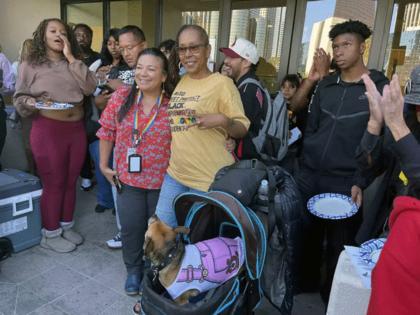Revised LAUSD budget saves jobs today, trims future retiree health benefit contributions
Published in News & Features
LOS ANGELES — The Los Angeles Board of Education on Tuesday approved an $18.8-billion budget that postpones layoffs for a year but pays for higher spending in part by reducing proposed contributions to a trust fund for retiree health benefits.
After a wide-ranging discussion Tuesday, the board approved a revised budget that removed $645 million over the next three years from contributions toward retiree health benefits to an account that could instead fund wage increases for employees, among other possible uses.
L.A. schools Supt. Alberto Carvalho said that, on the whole, the move was the right one.
"I tried to strike a balance between being somewhat risk averse, but not so much that we don't innovate and do right by our kids and our workforce," Carvalho said in during Tuesday's meeting.
That balance, he said, includes considering that "our workforce needs to remain our workforce, and we need stability associated with our workforce. And we need to recognize the cost of living in our community, the level of inflation our community, the level of housing costs in our community."
Employee contracts are currently under negotiation in the school system of about 400,000 students. The district, so far, has offered a 2% raise to its largest union for non-teaching staff. The teachers union has not yet received an offer.
Employee groups are pushing for more than 2%.
The shift of funds from future obligations to current needs came in the wake of an angry letter to the Board of Education signed by the eight employee unions.
"The district created a massive three-year deficit projection through this outrageous proposal to increase trust contributions by approximately 1,000%," the union letter stated. "This is a manufactured crisis, designed to confuse and divide people about our health benefits, and scare our school communities."
District officials continue to insist that the fund for retiree benefits is underfunded by about $8 billion, per actuarial studies. But there's also about $890 million currently in the fund.
That money is not yet being used. Instead, the district is paying for these benefits out of the general fund, at a cost of $315 million for the fiscal year that ends June 30. Ten years ago these benefits cost $150 million — and the figure is expected to continue to rise over the next several years, said Chief Financial Officer Chris D. Mount-Benites.
The revised budget moves in the direction of the union position. Instead of adding $335.7 million to the trust fund next year, the amount will be $142.6 million, for example.
The change was positive but a "far cry" from what the unions wanted, which was to eliminate the contribution entirely for the time being, said Adriana Salazar, president of Teamsters Union Local 572, which represents lower-level managers in the school system. Salazar also serves as chair of the L.A. Unified Health Benefits Committee, in which all the employee unions have a voice.
The next biggest alteration limited cuts to staffing at schools that would have taken effect a year from now. These cuts were targeted to save $60 million but the goal was reduced to $30 million instead. Some examples of jobs at risk include teacher aides, supervision aides and library aides.
A structural deficit
Revenue next year is currently calculated at $15.9 billion, nearly $3 billion less than what the district plans to spend. The district will continue to draw down an ending balance that stood at nearly $7 billion last year and now stands at about $4.8 billion.
The nation's second-largest school system has been able to sustain deficit spending because of reserves left over from more than $5 billion in one-time pandemic-relief aid.
However, absent cuts, by the end of 2027-28, the district will be financially underwater, officials say.
With a spending outlook in the red, state law required the Board of Education to approve a "fiscal stabilization plan," which will be overseen by the L.A. County Office of Education. The L.A. school board narrowly approved the plan last week.
For one more year, senior officials said no services to students are being cut and no full-time workers are losing employment and benefits — although some people are changing jobs and making less money. This will not be the story in the 2026-2027 academic year.
One looming cut is the closing of as many as 10 schools or, at the very least, under-used buildings at various campuses — saving $30 million per year. Shrinking central and regional offices is expected to save $325 million over two years.
Union leaders and activists, meanwhile, want more from a district reserve that still contains several billion dollars. This is evidence, they say, that L.A. Unified can pay higher wages and spend more to enhance programs for Black students and immigrants — efforts that defy President Donald Trump's push to end programs that promote racial or ethnic diversity.
Areas of investment
Last week, Carvalho announced an additional one-time augmentation of $50 million into the Black Student Achievement Plan, or BSAP, for the 2025-26 school year, bringing funding to $175 million. BSAP provides extra psychiatric social workers and academic counselors, among other enhancements.
There's already a sizable budget for making campuses greener, but Carvalho has agreed to add an additional $1 million a year over the next three years.
Immigrant families are expected to benefit from $5 million more for student centers — increased by $1 million since last week. Services can include legal referrals and other family support.
Activists wanted more, but also celebrated these gains in a rally outside district headquarters, in which school board member Karla Griego participated.
"It's always difficult when we start budget discussions with any future cuts to anything," Griego said during the board meeting. "So I want to take a moment to commend all the folks who advocated for the past few weeks, couple of months maybe, for our most marginalized populations."
©2025 Los Angeles Times. Visit at latimes.com. Distributed by Tribune Content Agency, LLC.







Comments